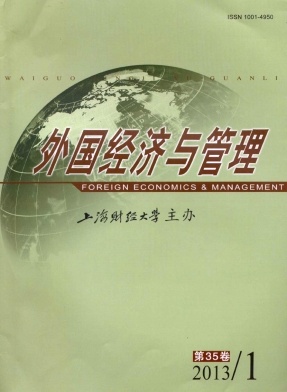悖论视角下的领导者—追随者契合研究探析
外国经济与管理 2013 年 第 35 卷第 01 期, 页码:55 - 62
摘要
参考文献
摘要
组织管理研究领域的悖论理论因应当前复杂多变的组织内外部环境而产生,它允许对组织领导过程中的领导者和追随者同时予以关注,并认为双方通过在相应特质或行为方面的协同,而达到领导者—追随者契合的良好状态,进而使领导活动收到理想的效果。本文在简单梳理悖论理论的基础上,重点按照悖论视角的思想同时从领导者和追随者双方出发,对领导者—追随者契合研究的典型范例和实证分析策略进行了述评,并对该领域的研究进行了总结和展望。
③详细情况参阅Edward和Parry(1993)。
[1]Bateman T S and Crant J M.The proactive component of or-ganizational behavior:A measure and correlates[J].Journal of Organizational Behavior,1993,14(2):103-118.
[2]Bedeian A G and Hunt J G.Academic amnesia and vestigial assumptions of our forefathers[J].Leadership Quarterly,2006,17(2):190-205.
[3]Cameron K S and Quinn R E.Organizational paradox and transformation[A].Quinn R E and Cameron K S(Eds.).Par-adox and transformation:Toward a theory of change in orga-nizations and management[C].Cambridge,MA:Ballinger,1988:12-18.
[4]Campbell D J.The proactive employee:Managing workplace initiative[J].Academy of Management Executive,2000,14(3):52-66.
[5]Cheung G W.Introducing the latent congruence model for im-proving the assessment of similarity,agreement,and fit in or-ganizational research[J].Organizational Research Methods,2009,12(1):6-33.
[6]Collinson D.Dialectics of leadership[J].Human Relations,2005,58(11):1419-1442.
[7]DeRue D S and Ashford S J.Who will lead and who will fol-low?Asocial process of leadership identity construction in or-ganizations[J].Academy of Management Review,2010,35(4):627-647.
[8]Edwards J R and Parry M E.On the use of polynomial regres-sion equations as an alternative to difference scores in organi-zational research[J].Academy of Management,1993,36(6):1577-1613.
[9]Edwards J R.The study of congruence in organizational beha-vior research:Critique and a proposed alternative[J].Organi-zational Behavior and Human Decision Processes,1994,58(1):51-100.
[10]Edwards J R.Latent variable modeling in congruence re-search current problems and future directions[J].Organiza-tional Research Methods,2009,12(1):34-62.
[11]Fiol C M.Capitalizing on paradox:The role of language in transforming organizational identities[J].Organization Sci-ence,2002,13(6):653-666.
[12]Gemmill G and Oakley J.Leadership:An alienating social myth?[J].Human Relations,1992,45(2):113-129.
[13]Gronn P.Distributed leadership as a unit of analysis[J].Lea-dership Quarterly,2002,13(4):423-451.
[14]Gupta A K,et al.The interplay between exploration and ex-ploitation[J].Academy of Management Journal,2006,49(4):693-706.
[15]Kristof-Brown A L,et al.Consequences of individuals’fit at work:A meta-analysis of person-job,person-organization,per-son-group,and person-supervisor fit[J].Personnel Psycho-logy,2005,58(2):281-342.
[16]Küpers W and Weibler J.Inter-leadership:Why and how should we think of leadership and followership integrally?[J].Leadership,2008,4(4):443-475.
[17]Lewis M W.Exploring paradox:Toward a more comprehen-sive guide[J].Academy of Management Review,2000,25(4):760-776.
[18]Li N,et al.The role of proactive personality in job satisfaction and organizational citizenship behavior:A relational perspective[J].Journal of Applied Psychology,2010,95(2):395-404.
[19]Luthans F and Stewart T I.A general contingency theory of management[J].Academy of Management Review,1977,2(2):181-195.
[20]Meindl J R.The romance of leadership as a follower-centric theory:A social constructionist approach[J].Leadership Quarterly,1995,6(3):329-341.
[21]Morrison E.OB in AMJ:What is hot and what is not?[J].Academy of Management Journal,2010,53(5):932-936.
[22]Pratt M G and Foreman P O.Classifying managerial respon-ses to multiple organizational identities[J].Academy of Ma-nagement Review,2000,25(1):18-42.
[23]Shanock L R,et al.Polynomial regression with response sur-face analysis:A powerful approach for examining moderation and overcoming limitations of difference scores[J].Journal of Business and Psychology,2010,25(4):543-554.
[24]Smith W K and Lewis M W.Toward a theory of paradox:A dynamic equilibrium model of organizing[J].Academy of Ma-nagement Review,2011,36(2):381-403.
[25]Thompson J A.Proactive personality and job performance:A social capital perspective[J].Journal of Applied Psychology,2005,90(5):1011-1017.
[26]Tinsley H E A.The congruence myth:An analysis of the ef-ficacy of the person-environment fit model[J].Journal of Vo-cational behavior,2000,56(2):147-179.
[27]Tosi Jr H L and Slocum Jr J W.Contingency theory:Some suggested directions[J].Journal of Management,1984,10(1):9-26.
[28]Zhang Z,et al.Leader-follower congruence in proactive per-sonality and work outcomes:The mediating role of leader-member exchange[J].Academy of Management Journal,2012,55(1):111-130.
[1]Bateman T S and Crant J M.The proactive component of or-ganizational behavior:A measure and correlates[J].Journal of Organizational Behavior,1993,14(2):103-118.
[2]Bedeian A G and Hunt J G.Academic amnesia and vestigial assumptions of our forefathers[J].Leadership Quarterly,2006,17(2):190-205.
[3]Cameron K S and Quinn R E.Organizational paradox and transformation[A].Quinn R E and Cameron K S(Eds.).Par-adox and transformation:Toward a theory of change in orga-nizations and management[C].Cambridge,MA:Ballinger,1988:12-18.
[4]Campbell D J.The proactive employee:Managing workplace initiative[J].Academy of Management Executive,2000,14(3):52-66.
[5]Cheung G W.Introducing the latent congruence model for im-proving the assessment of similarity,agreement,and fit in or-ganizational research[J].Organizational Research Methods,2009,12(1):6-33.
[6]Collinson D.Dialectics of leadership[J].Human Relations,2005,58(11):1419-1442.
[7]DeRue D S and Ashford S J.Who will lead and who will fol-low?Asocial process of leadership identity construction in or-ganizations[J].Academy of Management Review,2010,35(4):627-647.
[8]Edwards J R and Parry M E.On the use of polynomial regres-sion equations as an alternative to difference scores in organi-zational research[J].Academy of Management,1993,36(6):1577-1613.
[9]Edwards J R.The study of congruence in organizational beha-vior research:Critique and a proposed alternative[J].Organi-zational Behavior and Human Decision Processes,1994,58(1):51-100.
[10]Edwards J R.Latent variable modeling in congruence re-search current problems and future directions[J].Organiza-tional Research Methods,2009,12(1):34-62.
[11]Fiol C M.Capitalizing on paradox:The role of language in transforming organizational identities[J].Organization Sci-ence,2002,13(6):653-666.
[12]Gemmill G and Oakley J.Leadership:An alienating social myth?[J].Human Relations,1992,45(2):113-129.
[13]Gronn P.Distributed leadership as a unit of analysis[J].Lea-dership Quarterly,2002,13(4):423-451.
[14]Gupta A K,et al.The interplay between exploration and ex-ploitation[J].Academy of Management Journal,2006,49(4):693-706.
[15]Kristof-Brown A L,et al.Consequences of individuals’fit at work:A meta-analysis of person-job,person-organization,per-son-group,and person-supervisor fit[J].Personnel Psycho-logy,2005,58(2):281-342.
[16]Küpers W and Weibler J.Inter-leadership:Why and how should we think of leadership and followership integrally?[J].Leadership,2008,4(4):443-475.
[17]Lewis M W.Exploring paradox:Toward a more comprehen-sive guide[J].Academy of Management Review,2000,25(4):760-776.
[18]Li N,et al.The role of proactive personality in job satisfaction and organizational citizenship behavior:A relational perspective[J].Journal of Applied Psychology,2010,95(2):395-404.
[19]Luthans F and Stewart T I.A general contingency theory of management[J].Academy of Management Review,1977,2(2):181-195.
[20]Meindl J R.The romance of leadership as a follower-centric theory:A social constructionist approach[J].Leadership Quarterly,1995,6(3):329-341.
[21]Morrison E.OB in AMJ:What is hot and what is not?[J].Academy of Management Journal,2010,53(5):932-936.
[22]Pratt M G and Foreman P O.Classifying managerial respon-ses to multiple organizational identities[J].Academy of Ma-nagement Review,2000,25(1):18-42.
[23]Shanock L R,et al.Polynomial regression with response sur-face analysis:A powerful approach for examining moderation and overcoming limitations of difference scores[J].Journal of Business and Psychology,2010,25(4):543-554.
[24]Smith W K and Lewis M W.Toward a theory of paradox:A dynamic equilibrium model of organizing[J].Academy of Ma-nagement Review,2011,36(2):381-403.
[25]Thompson J A.Proactive personality and job performance:A social capital perspective[J].Journal of Applied Psychology,2005,90(5):1011-1017.
[26]Tinsley H E A.The congruence myth:An analysis of the ef-ficacy of the person-environment fit model[J].Journal of Vo-cational behavior,2000,56(2):147-179.
[27]Tosi Jr H L and Slocum Jr J W.Contingency theory:Some suggested directions[J].Journal of Management,1984,10(1):9-26.
[28]Zhang Z,et al.Leader-follower congruence in proactive per-sonality and work outcomes:The mediating role of leader-member exchange[J].Academy of Management Journal,2012,55(1):111-130.
引用本文
张军成, 凌文辁. 悖论视角下的领导者—追随者契合研究探析[J]. 外国经济与管理, 2013, 35(1): 55–62.
导出参考文献,格式为:
下一篇:管理学批判理论述评





 9751
9751  873
873

